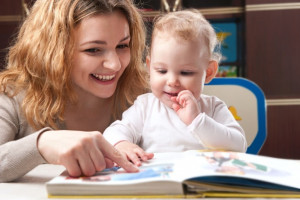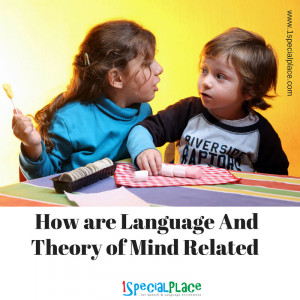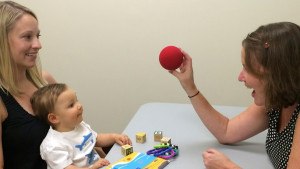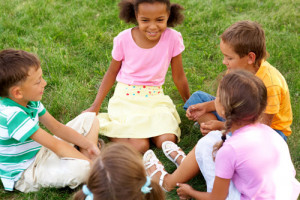How Are Language And Theory of Mind Related
How Are Language And Theory of Mind Related
This article has been written by Leia Knight . Original Article – The Connection between Language and Theory of Mind
Language is the key to developing Theory-of-Mind.
Here are some books on Theory of Mind
Theory of Mind : How Children Understand Each Others’ Thoughts and Feelings
Mindblindness : An essay on Autism and Theory of Mind
Introduction on Theory of Mind – Children, Autism and Apes
Language isn’t only the key to Theory-of-Mind but it is”the only ability that has clearly been shown to be directly related to Theory-of-Mind competence” (pg. 28). That’s a pretty strong statement.
So if you want your child to have Theory-of-Mind, then you must develop their language skills. But let’s back up for a sec, why is Theory-of-Mind (ToM) even something you should be concerned about?
ToM matters because it’s social cognition. When your child has ToM, they’re able to recognize that others’ have unique perspectives and beliefs and that these things affect others’ actions. ToM is also a big factor in peer acceptance and having positive social interactions with friends.
If you have ToM, then you know that not everyone thinks like you do and knows all of the information that you know. And you not only know this, but you also know about others’ beliefs and perspectives.
So how does language help a child develop the skills needed to recognize and understand others’ perspectives, beliefs, and actions?
Language helps your child do these things because it’s what your child needs to put together how “emotions, thoughts, and actions are linked over time” (pg. 67).
The specific language skills you need to teach your child in order to develop their ToM are vocabulary, basic concepts, story telling and recall, and syntax.
Let’s dig in to all these language skills!
Vocabulary
There are three types of vocabulary words you need to teach your child for ToM development. These words help your child to learn about how others perceive, interact with, and feel about the world. Here are the three categories of vocabulary and why each one is important.
- Cognition
- Your child needs to have words to describe ‘mental states’ or the things going on inside someone’s head.
- Examples: think, know, remember, guess, perceive, intend, believe, suspect, assume & imagine
- Perception
- These are the words that describe how someone interacts with the physical world.
- Examples: see, hear, touch, feel
- Emotion
- These words are pretty self-explanatory.
- Examples: happy, sad, angry, excited, frustrated
Perception and emotion are the vocabulary that your child begins to learn around the age of 2. Around 4 years old, your child begins to learn the words for cognition.
Keep in mind that these are the ages when the vocabulary emerges. Children may say some words and phrases before they really have an in-depth understanding of a them.
 Basic Concepts
Basic Concepts
Your child needs to be able to tell if something is real or pretend.
This concept of imaginary vs. real is something you see a child catch on to when they started using more advanced play skills like pretend play. Seeing a child pretend to play “school” is not only super adorable, but also an indicator that your child is beginning to distinguish between what is real and pretend in the here and now.
Story Telling
Your child needs to how to tell a story so that they learn how to think of events logically and connect cause and effects. Story telling is really important because your child needs to be able to explain how “emotions, thoughts, and actions are linked over time” (pg. 67) to develop ToM.
Syntax
When your child is explaining cause and effect and how things are connected, there are some specific sentence types they need to know. (btw, this portion on syntax is from my musings on the topic and not directly from the ebook this post was developed from.)
The conjunctions “but” and “so” are key elements your child needs to know how to use in sentences to talk about ToM.
“But” is important because your child uses it to identify and describe differences…. which is what ToM is all about. With ToM, your child is recognizing, identifying, and understanding the differences in how others’ think.
“So” is the next conjunction that you need to focus on teaching your child. “So” can be used to describe cause and effect which is super important for ToM because your child needs to connect others’ thoughts, perspectives, and emotions with their actions.
Now how does your child develop all these language skills?
Developing close relationships with people like parents, grandparents, and siblings are really important because it’s within the interactions of these relationships that your child is first exposed to others’ thoughts, beliefs, and actions.
When you think about it, it feels so intuitive. When mom accidentally breaks a glass and is sad, the toddler sees this. In this scenario, your child would have an opportunity to learn that you have a different reaction than them to the same event.
It’s in these natural and spontaneous interactions that you can really help your child begin to recognize that others are different by talking about your thoughts, emotions and perspectives. When you talk, use the vocabulary that describes cognition, perception and emotion. Instead of just saying “I’m sad,” provide more explanation by saying “I’m sad because ____.”
Your child may not understand everything, like that your frustrated that the milk spilled because you’ve already spent your allotted grocery budget this month…. but your child needs to be exposed to these situations and explanation so that they can begin to develop ToM.
And your child probably won’t hear as many explanations like this outside of these close relationships. For example, your child may see that the cashier at the grocery looks sad but won’t hear the explanation and have an opportunity to connect that emotion with a belief, thought or action.
In addition to discussing the cause & effect of your emotions, thoughts and actions; you can use simple strategies to help your child develop ToM. These additional strategies you can use are how you read books together, encouraging your child’s pretend play skills and providing opportunities for your child to learn to use conjunctions.
Let’s tie language, Theory-of-Mind and social skills all together
Your child needs to develop language skills to develop ToM. ToM is incredibly important because it’s the foundation your child needs to develop social skills. Social skills have a big impact on your child’s success in the classroom and on the playground.
Language, ToM and social skills are all connected and interdependent. Help your child build these critical skills so that your child can develop the social skills needed to be successful on the playground and become socially competence individuals.
Reference:
(Astington, J. W., & Baird, J. A. (Eds.). (2005). Why language matters for theory of mind. Retrieved from here)
Please leave us a reply. You can also sign up for our newsletter.
- Addressing the Silent Struggle in Special Needs Children - December 22, 2023
- Swallowing Difficulties: A Comprehensive Guide - December 12, 2023
- 6 Simple Steps to Enhance Speech Clarity and Connect with Confidence - November 3, 2023







Leave a Comment
(0 Comments)